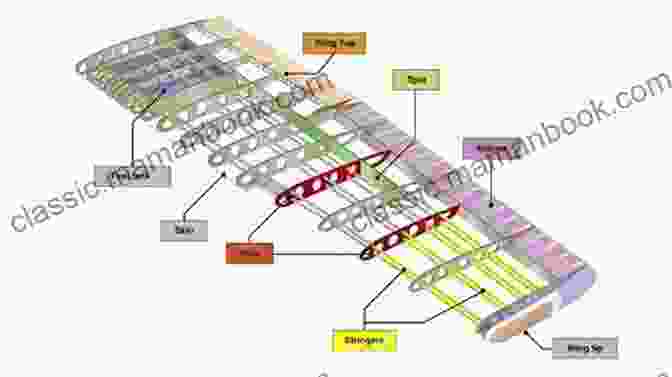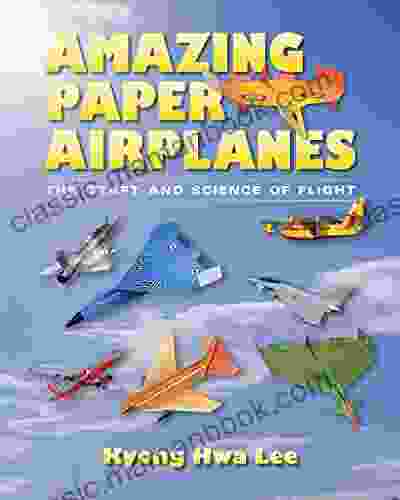The Craft and Science of Flight: Unraveling the Secrets of Aviation

4.3 out of 5
| Language | : | English |
| File size | : | 19772 KB |
| Text-to-Speech | : | Enabled |
| Screen Reader | : | Supported |
| Enhanced typesetting | : | Enabled |
| Word Wise | : | Enabled |
| Print length | : | 288 pages |
| Lending | : | Enabled |
Since the dawn of time, humans have yearned to conquer the skies, to break free from the constraints of gravity and soar through the boundless expanse above. The dream of flight has captivated our imaginations, inspiring countless legends and myths. Today, the ability to take to the air is a testament to human ingenuity, a triumph of engineering and scientific understanding.
The realm of aviation is a fascinating intersection of art and science, where the delicate dance of aerodynamics meets the relentless pursuit of innovation. In this article, we delve into the intricate workings of flight, exploring the principles that govern the movement of aircraft and unraveling the secrets that make this extraordinary feat possible.
The Wings of Flight: Aerodynamics Unraveled
The key to understanding the science of flight lies in the phenomenon of aerodynamics. Aerodynamics examines the movement of air and its interactions with solid objects, providing insights into how aircraft generate lift, control their flight, and ultimately soar through the heavens. At the heart of aerodynamics lies the concept of lift, the force that counteracts gravity and allows aircraft to stay aloft.

Lift is generated by the shape of the aircraft's wings. The wings are designed with a curved upper surface and a flatter lower surface, creating an airfoil shape. As the aircraft moves through the air, the air flowing over the wing's upper surface travels faster than the air flowing over the нижней части. This difference in speed creates a pressure differential, with lower pressure above the wing and higher pressure below. This pressure difference generates an upward force known as lift.
In addition to lift, aerodynamics also governs aircraft stability and control. Control surfaces, such as ailerons, rudders, and elevators, are used to adjust the aircraft's attitude and trajectory. By manipulating these control surfaces, pilots can maneuver the aircraft, changing its direction and altitude as needed.
Engineering Marvels: Aircraft Design and Construction
The design and construction of aircraft are intricate endeavors, requiring a deep understanding of aerodynamics, engineering principles, and materials science. Aircraft designers strive to create structures that are both lightweight and strong, capable of withstanding the forces of flight while maximizing efficiency.
The primary structural components of an aircraft include the fuselage, wings, tail, and landing gear. The fuselage houses the aircraft's occupants, cargo, and systems. The wings generate lift and provide stability. The tail, consisting of the vertical stabilizer and horizontal stabilizer, ensures directional stability and helps control the aircraft's pitch and yaw. The landing gear supports the aircraft during takeoff and landing.

Aircraft construction involves the use of advanced materials such as lightweight alloys, composite materials, and high-strength plastics. These materials offer a combination of strength, durability, and reduced weight, optimizing the aircraft's performance and enhancing its overall efficiency.
The Human Factor: Pilots and Flight Operations
While the science of flight provides the foundation for aviation, the human factor plays a crucial role in the safe and successful operation of aircraft. Pilots are highly skilled individuals who undergo extensive training to master the art of flying. They must possess a deep understanding of aerodynamics, navigation, meteorology, and aircraft systems.
Flight operations involve a complex interplay between the pilot, the aircraft, and the environment. Pilots monitor multiple systems, make real-time decisions, and respond effectively to changing conditions. They must possess excellent hand-eye coordination, spatial awareness, and the ability to remain calm under pressure.
Advancements in technology have significantly aided pilots in their operations. Advanced avionics systems provide real-time information on aircraft performance, navigation, and weather conditions. Autopilot systems assist with flight control, reducing pilot workload and enhancing safety.
History of Flight: Charting the Milestones of Innovation
The journey of aviation is marked by a series of remarkable milestones, each pushing the boundaries of human ingenuity and expanding our capabilities in the sky. From the early attempts at controlled flight to the dawn of commercial aviation and the development of supersonic jets, the history of flight is a testament to the relentless pursuit of innovation.
Key milestones in the history of flight include:
- 1783: The Montgolfier brothers demonstrate the first successful hot air balloon flight.
- 1853: George Cayley pioneers the use of fixed wings for lift and stability in gliders.
- 1903: The Wright brothers achieve the first controlled, powered flight in an airplane.
- 1919: Alcock and Brown make the first transatlantic flight.
- 1952: De Havilland Comet becomes the first commercial jetliner.
- 1969: Neil Armstrong and Buzz Aldrin become the first humans to walk on the Moon.
- 2007: Airbus A380 enters service, becoming the world's largest passenger aircraft.
The continuous advancements in aviation technology have revolutionized global travel, facilitated global commerce, and connected people across continents. Today, aviation remains a vital industry, shaping our world in countless ways.
Future of Flight: Exploring the Next Frontiers
As we look to the future of flight, the possibilities seem boundless. Ongoing research and development are paving the way for innovative aircraft designs, advanced propulsion systems, and autonomous flight technologies. The future of flight holds the promise of:
- Electric aircraft that offer reduced emissions and quieter operations.
- Supersonic commercial travel, significantly reducing travel times between distant destinations.
- Vertical takeoff and landing (VTOL) aircraft, enabling takeoff and landing from urban areas.
- Autonomous flight systems that enhance safety and efficiency, reducing pilot workload.
- Space tourism, opening up new frontiers for adventure and exploration.
The future of flight is poised to be as transformative as its past, with new technologies and groundbreaking innovations shaping the way we travel, explore, and connect with the world around us.
The craft and science of flight is a captivating realm where art and science converge, where human ingenuity and innovation take to the skies. From the intricate design of aircraft to the skilled hands of pilots, the journey of aviation is a symphony of precision, knowledge, and perseverance. As we continue to explore the uncharted territories of flight, the future holds endless possibilities, promising to redefine the way we travel, connect, and push the boundaries of human imagination.
4.3 out of 5
| Language | : | English |
| File size | : | 19772 KB |
| Text-to-Speech | : | Enabled |
| Screen Reader | : | Supported |
| Enhanced typesetting | : | Enabled |
| Word Wise | : | Enabled |
| Print length | : | 288 pages |
| Lending | : | Enabled |
Do you want to contribute by writing guest posts on this blog?
Please contact us and send us a resume of previous articles that you have written.
 Top Book
Top Book Novel
Novel Fiction
Fiction Nonfiction
Nonfiction Literature
Literature Paperback
Paperback Hardcover
Hardcover E-book
E-book Audiobook
Audiobook Bestseller
Bestseller Classic
Classic Mystery
Mystery Thriller
Thriller Romance
Romance Fantasy
Fantasy Science Fiction
Science Fiction Biography
Biography Memoir
Memoir Autobiography
Autobiography Poetry
Poetry Drama
Drama Historical Fiction
Historical Fiction Self-help
Self-help Young Adult
Young Adult Childrens Books
Childrens Books Graphic Novel
Graphic Novel Anthology
Anthology Series
Series Encyclopedia
Encyclopedia Reference
Reference Guidebook
Guidebook Textbook
Textbook Workbook
Workbook Journal
Journal Diary
Diary Manuscript
Manuscript Folio
Folio Pulp Fiction
Pulp Fiction Short Stories
Short Stories Fairy Tales
Fairy Tales Fables
Fables Mythology
Mythology Philosophy
Philosophy Religion
Religion Spirituality
Spirituality Essays
Essays Critique
Critique Commentary
Commentary Glossary
Glossary Bibliography
Bibliography Index
Index Table of Contents
Table of Contents Preface
Preface Introduction
Introduction Foreword
Foreword Afterword
Afterword Appendices
Appendices Annotations
Annotations Footnotes
Footnotes Epilogue
Epilogue Prologue
Prologue Stan Brock
Stan Brock Raleigh Briggs
Raleigh Briggs Lydia Olson
Lydia Olson Ross W Greene
Ross W Greene Heather Grzych
Heather Grzych Donna Ball
Donna Ball Mariah Emanii
Mariah Emanii The Church Of Jesus Christ Of Latter Day Saints
The Church Of Jesus Christ Of Latter Day Saints Tawanda King Cheek
Tawanda King Cheek Julia B Kingsley
Julia B Kingsley Michael Matthews
Michael Matthews Ashura Adam
Ashura Adam Techexp Academy
Techexp Academy Petros C Mavroidis
Petros C Mavroidis Geoffrey C Fuller
Geoffrey C Fuller Carline Crevecoeur
Carline Crevecoeur Ken Shores
Ken Shores John Ruhlin
John Ruhlin Charles Morris
Charles Morris Joanne Steer
Joanne Steer
Light bulbAdvertise smarter! Our strategic ad space ensures maximum exposure. Reserve your spot today!

 Roberto BolañoFuneral March Of Marionette Saxophone Quartet Set Of Parts: A Comprehensive...
Roberto BolañoFuneral March Of Marionette Saxophone Quartet Set Of Parts: A Comprehensive...
 Richard SimmonsThe Ultimate Guide to ACT Prep: Study Strategies, Test Tips, and Practice...
Richard SimmonsThe Ultimate Guide to ACT Prep: Study Strategies, Test Tips, and Practice... Fernando BellFollow ·19.5k
Fernando BellFollow ·19.5k Jessie CoxFollow ·17.3k
Jessie CoxFollow ·17.3k Howard PowellFollow ·14.5k
Howard PowellFollow ·14.5k Jermaine PowellFollow ·15.1k
Jermaine PowellFollow ·15.1k Junot DíazFollow ·4.9k
Junot DíazFollow ·4.9k Roberto BolañoFollow ·2.4k
Roberto BolañoFollow ·2.4k Jason HayesFollow ·18.1k
Jason HayesFollow ·18.1k Jaylen MitchellFollow ·11.7k
Jaylen MitchellFollow ·11.7k

 Bryan Gray
Bryan GrayCello Alternativo: Exploring Contemporary Pizzicato...
: Embracing the Avant-Garde Within...

 Victor Hugo
Victor HugoThe Social Revolution: Barry Libert's Vision for a More...
In a world where...

 Tony Carter
Tony CarterA Comprehensive Guide to Crafting Clear and Effective Job...
A job description is a critical tool...

 Deacon Bell
Deacon BellSelected Poems And Prose Lorenzo Da Ponte Italian Library
Lorenzo Da Ponte, born...

 Francisco Cox
Francisco CoxWhat You Need To Know About Opportunity Cost: A...
Opportunity cost is a fundamental concept...

 Bill Grant
Bill GrantWhy Our Kids With Behavioral Challenges Are Falling...
Every year,...
4.3 out of 5
| Language | : | English |
| File size | : | 19772 KB |
| Text-to-Speech | : | Enabled |
| Screen Reader | : | Supported |
| Enhanced typesetting | : | Enabled |
| Word Wise | : | Enabled |
| Print length | : | 288 pages |
| Lending | : | Enabled |








